Article written by Michael Beisty (c) Runner’s Tribe
Steve Poulton was part of a wave of upcoming distance runners that bridged the Manning, Farrington, Robinson, Stanley, Nee, Lotty, Toogood and McDonald era to a new awakening of NSW talent during the late 1970s. He was the ultimate clubman. Hardworking, he eventually landed in the marathon arena.
If I could use one word to describe Steve it would be consistency. While Steve was at or near the top of the pile within NSW for many years, he was always striving to do better. Self-coached, he learned what he could from mixing with the Victorians, and NSW elite athletes and coaches, to achieve national standards and international representation.
While his rise occurred at a time of fun run mania, Steve was selective in his choice of races, generally opting to support his club’s aspirations for team wins in association events over a prize-winning fun run. That’s not to say he didn’t run fun runs. It wasn’t something he could easily avoid, especially with prominent events like the Sutherland to Surf being held in his own backyard. However, Steve was a regular at NSW AAA events such as the Sutherland Half Marathon, the Parramatta 10 Miles, NSW Road Relays and other state road championships (notably the 25 kilometres), and the NSW Cross Country Championships (various distances).
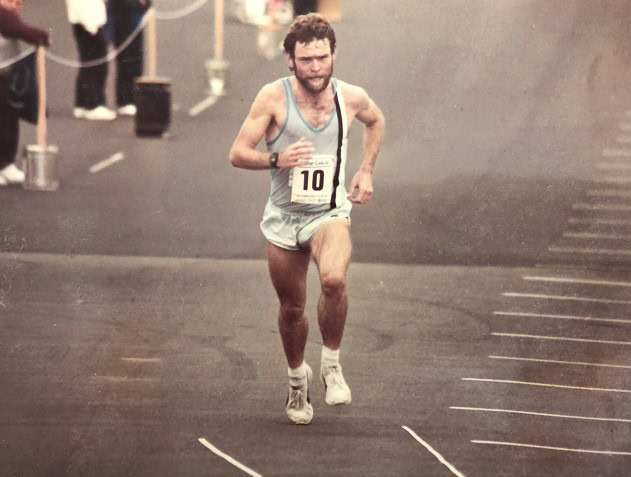
Steve won and placed in NSW championships on the road, cross country, and track. A quadruple NSW marathon champion, he also placed in national distance running events, and wore the Australian singlet six times. He represented Australia at three consecutive World Marathon Cups in the 1980s. Although he enjoyed cross country, and won a NSW championship, Steve’s preferred discipline was the road. He had an incredible drive to be the best he could possibly be. A trite cliche in some quarters, but not to those who only ever saw the back of Steve’s singlet. And there were many in that category.
It is notable that in Brian Lenton’s Distance Running in Australia (1978), in a self-written profile Steve finishes with the words ‘I have no real ambition, only to keep improving and perhaps to run a decent marathon one day.’ Twenty years of age at the time, and yet to make his mark, these casual words underscore Steve’s unassuming manner, and his approach to distance running that is evidenced throughout his career.
Retired from forty years employment in Local Government since 2019, these days Steve finds solace in riding and walking, rather than running. Ten years ago, he tore a meniscus in his left knee, which was not able to be rehabilitated and resulted in replacement surgery. He has restricted knee movement and his walking gait is affected. During the past ten years he has gravitated to road and mountain bike riding, and more recently he has purchased a paddle ski, a new adventure.
While researching his background, I uncovered many race reports, profiles and statements about Steve and I am pleased to have this opportunity to showcase this much underrated athlete.
Personal Bests and Key Races
1500 metres: 3:55, Sydney, 1981
3000 metres: 8:14.4, Taurunga, New Zealand, 1980
5000 metres: 14:09.79, Auckland, New Zealand, 1984
10000 metres: 29:08.74, Melbourne, 1981
15 kilometres: 45:23, Perth, 1989
25 kilometres: 77:44, Perth, 1981*
Half marathon: 65:43, Sutherland, 1981
Marathon: 2:16:41, Invercargill, New Zealand, 1988
City to Surf: 42:38, Sydney, 1983
* Steve ran 77:39 to finish eighth in the Australian Championship at Adelaide in 1983. However, Steve advised me the course was widely recognised as short.
Steve never really had a proper go at the City to Surf, his best performances being sixth in 1979 43:40, fourth in 1983 42:38, and eighth in 1987 42:41.
Steve indicated there were several races where ‘I ran better than I expected’, the standouts being a second place to Steve Austin in the 1980 Bacchus 12000, and third place in the Australian 25 kilometres Road Championships in Perth in 1981. He states that ‘Having only run my second marathon (2:17:07) three weeks earlier, I finished behind Rob DeCastella’s 74:42, which, if I recall was the second fastest 25 kilometres in the world at the time. My good mate Lawrie Whitty ran 76:27. I ran 77:44.’
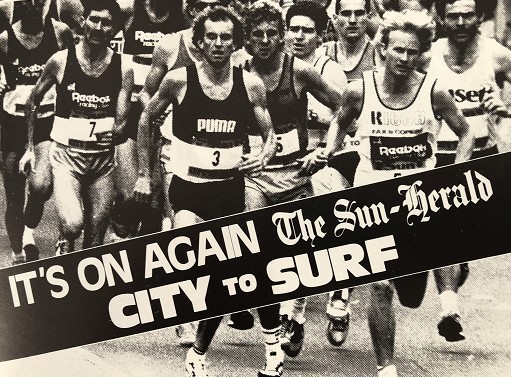
Steve was a prolific racer of all distances. He always seemed to be racing something and it was not unknown for Steve to back up in another competitive event within a few days or even the next day, after top AAA races. Although it proved a difficult exercise, picking up on the theme of running ‘better than I expected’, apart from marathons, I have identified a series of other key race events that encapsulate his career:
Sutherland Half Marathon
Zatopek 10000 metres Track Classic
The Bacchus 12000
Cross Country Championships
Parramatta 10 Miles
Steve didn’t compete in many half marathons, the 10 mile and 25 kilometres being the prevalent longer distance races early in his career. Half marathons really weren’t much of a thing, only coming into vogue from the mid 1980s onwards. And while the Sutherland Half Marathon attracted some top NSW distance runners in its day, the course was undulating, the running surface often uneven and rutted from the weather and cars during the late 1970s.
1. Early Days
Steve was born on 11 September 1957 in Cambridge, England, and immigrated to Australia with his family under the auspices of the ‘Ten Pound Pom’ program in 1969. The Poulton family settled in Gymea in the Sutherland Shire. Steve has always lived within Sutherland, close to the Royal National Park, which became his stomping ground for training. He studied at the NSW Institute of Technology (NSWIT) in the late 1970s and once qualified he married his love for running with his employment as a civil engineer in Local Government. He won several Intervarsity cross-country races and was awarded the first ever NSWIT Sports Blue for Athletics in 1981.
Steves’ mother did many years of charity work for disability services and not-for profit organisations. His father was a printer by trade. His parents were avid cyclists. Steve recalls that ‘Mum and Dad would watch my big races. They didn’t give coaching advice. I’d go out on bike rides with them when injured, or sometimes with members of Sutho Bike Club of which I’m still a member.’
1.1 Teenage Development
Steve acknowledges the influence of Joe Flick in his very early days, ‘who was a very talented sports guy when we were younger, played first grade rugby league and was a very good runner in his school days. Joe got me into running and I started running around the block after school when I was 15 so I could keep up with him.’

Steve’s relationship with running commenced in a formal sense during September 1972 after finishing second in a schools 1500 metres race in around 5:05. Next race, 4:44 and still untrained, he was on his way, to be forever linked to the Sutherland District Amateur Athletics Club (DAAC). Steve joined Ernie Etherton’s small squad that included Greg Hoare, Peter Cotton, Dave Ramsey and Ernie’s son, Richard. He lasted three or four years with Ernie before drifting away from the group. The squads program included staples of trackwork once per week, and a ten mile long run at Heathcote on a Sunday afternoon. Steve recalls that during this time ‘I got to know several of the senior Sutherland runners like Dennis French, Peter Simpson, the Beeson bothers (Nigel, Dave and Clive), Matt Frost, Harry Ward and Mal Lynn who I trained with regularly. I got a lot of good advice from all of them. Peter Hutton was in my age group for short periods, being 18 months older than me, and Ian Graves was also around.’
Throughout his career track work was mainly done with a core group of Murray Halls, Dean Simes, Gary Schumak, Hoare, Simpson and Lynn. Steve relates that ‘I’ve trained with many Sydney based runners over the years. We always had a great group of guys from the south of Sydney who’d run Lady Carrington Drive throughout the 1980’s and 1990’s on Sunday mornings and a group of mainly Sutherland guys who’d do track sessions at Sylvania Waters Track in the 1980s.’
Upon joining Sutherland in 1972 Steve was told by a club official that he was too slow to be any good. However, by the end of the 1973-74 track season he ran 4:01 and 8:39 for 1500 metres and 3000 metres respectively – very quick early progress. He even ran a 4:24 1500 steeple for 10th in the 1974 Junior Nationals.
Steve’s development was steady as she goes, with bursts of brilliance shining through. While he definitely had his ups and downs, he passed through the traumas of mid-teen racing relatively unscathed. He raced regularly in club events, and was highly competitive in NSW AAA and school championships, with many wins and top three places to his name.
He proved his real potential in the winter of 1974. Aged 16, he placed third in the NSW Novice Cross Country Championship behind open athlete Tony Green of Newcastle, won the NSW Sub Junior (under 17) Cross Country Championship by a street, and placed 13th in the Australian Junior 10 kilometres Cross Country Championship in Perth, two minutes behind crow-eater Tony Bart who beat a young Deek and Victorian Bryan Lewry. In between everything else, he ventured into Victoria and finished fourth in the Victorian Schoolboys Cross Country Championship behind winner Steve Foley. An obligatory run in the City to Surf gave Steve an impressive 30th place and a good end to the winter season.
Other teenage highlights include three consecutive wins in the annual NSW Schoolboys Cross Country Championship and a National Combined High School (CHS) 1500 metres championship win during his last year of high school. His regular opponents included Jeff Thompson, Greg Dunford, Graeme Cook and Colin Dunn, most to become well credentialed competitors at state and national levels.
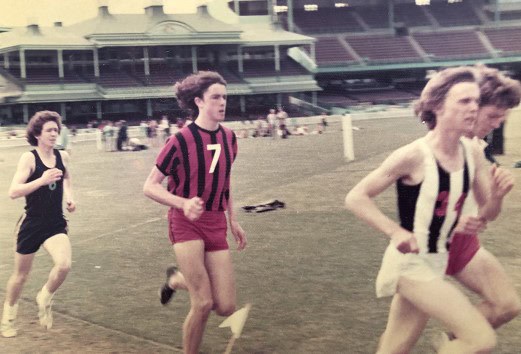
1.2 Junior Potential
Entering the junior age category (under 19) Steve was touted by NSW pundits as a ‘rising star’. He had a proven ability to race tough and dig deep in close fought affairs, or push himself while all alone, and it didn’t go unnoticed. While the depth of distance running talent was thin in NSW junior club ranks, the standard at the pointy end was white hot. The most notable of Steve’s age peers were a trio of future internationals John Andrews, Andrew Lloyd, and a much younger Whitty, and a raw talent in Dunford who eventually fell out of distance running. Quentin Morley and Danny Boltz were in the shadows.
Steve has an abiding memory of finishing second to Gerard Barrett in the 1975 NSW Junior 3000 metres Track Championship. Racing above his form at that time he beat all the major NSW contenders collapsing in a heap at the finish. This was all he could have reasonably hoped for, Barrett being the prodigious talent that he was.
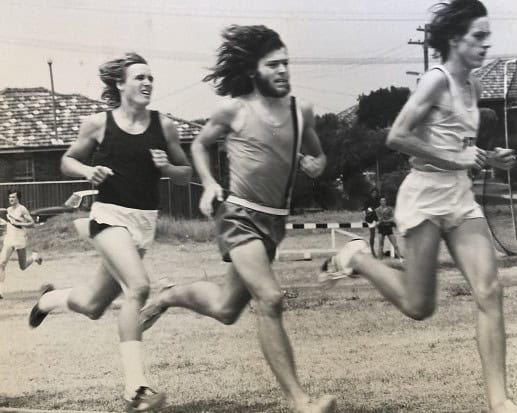
However, his performances at the 1974-75 Australian Track and Field Championships were lack lustre: fifth in the junior 1500 metres in 4:01.6 and another 10th in the steeplechase in a slow 4:33. Of AAA junior events Steve considers his best performance was fourth place in the 1975 Australian Cross Country Championship, held in Minda Farm, Adelaide. The distance was 10 kilometres. While Deek smashed the field with a 90 second win over Queenslanders Barrett and George Fewtrell, Steve was only 19 seconds behind Barrett and eight seconds adrift of Fewtrell.
Later, during the 1975-76 track season, he suffered a severe downturn in his race performances, culminating with a ninth place in the Australian Junior 1500 metres championship (3:59.9) and second last in the 5000 metres (15:49). To rub salt into the wounds, his fellow Waratahs of Andrews, Dunford and Whitty performed the trifecta in the 5000 metres, all over one minute ahead of Steve. For Steve, something had gone wrong, and while he didn’t know it at the time, he was likely suffering from undiagnosed glandular fever.
From a young age Steve was a regular competitor in Sutherland DAAC’s major autumn fixture, that centred on its iconic half marathon. Held annually from 1972 in the Royal National Park on the first weekend of May, he cut his teeth in the age category races before eventually tackling the ‘half’. The full course (and age-based races) ran out and back along Lady Carrington Drive, starting at Audley. Steve describes it as a ‘goat track and undulating. It was a better surface in later years when they stopped cars driving on it.’
He takes some pride in his performances in the 1975 and 1976 Sutherland junior 10000 metre race, held in conjunction with the half. He won both years in times of 31:46 and 31:51, respectively. In the former, aged 17, a race report of Athletics Australia states that he ‘annihilated both the opposition and the course record with a superb 31:46’, beating the 1974 winner, Graeme Cook, by nearly 2 ½ minutes. His good form was confirmed a few weeks later when he ran one of the fastest legs in the NSW Senior 4 x 10km road relay championships of 31:20. In the 1976 race he won by nearly a minute, though only recently recovered from glandular fever.
While Steve was improving on road and country, his performances as a junior in the Australian Track and Field Championships of 1975 and 1976 proved uneventful, and his track times had stagnated to some degree. He finished his junior career with personal bests on the track of 1:57, 3:56, 8:28, 14:39 and 30:30. Steve reflects that ‘While I was more comfortable running on the road, I enjoyed track, when I had a good race, but I never had a lot of speed so found track tough most of the time. And I probably trained too hard on the track.’
At this early stage of his career, the die was cast for his eventual transition to marathon running, a four years subconscious migration where he upped the ante in his training focus of endurance and big mileage.
2. The Clubman
Steve’s loyalty to Sutherland DAAC was the thread that kept his career together. He still holds the club records for 10000 metres (29:20) and the marathon (2:16:41), set in 1980 and 1988 respectively. He jokes that the 10000 metres is ripe for the taking if Olley Hoare decides to move up.
From aspiring kid, to outstanding junior, and then promising open competitor, to an established international marathoner, Steve was supported by Sutherland, as he supported them. Despite a four years aberration (1981 to 1984) when he, and Andrew Lloyd, Danny Boltz and the Brennan brothers (David and Wayne), joined Western Suburbs, Steve remained a ‘Sutho’ clubman through and through.
‘Throughout my running career there were many inspiring moments, in my earlier years, just running a “PB” was always a great achievement, along with seeing mates I’d trained with or known, doing well in a race. It was always inspirational being part of a team who’d won a state cross country teams’ race or done well in a road relay. This is the closest any runner gets to being part of a successful team in an often- individual sport.’
Living and running in Sutherland during the 1970s was a great start to Steve’s running career. The club had a solid group of experienced distance runners who were competitive in NSW, particularly in the longer events up to the marathon, Ian Graves and Rob Davies being cases in point. A late starter to marathon running, Graves became a consistent sub 2:30 performer and winner of many marathons, into his forties. He was a regular placegetter at the NSW Championships. Graves won in 1982 beating Stephen Montague by one second, 2:23:54 to 2:23:55, won again in 1985, and achieved a repeat win over Montague in 1987 in the near identical time of 2:23:56 at 43 years of age. The erratic Davies, a mid 2:20s performer, won the NSW Marathon Championships in 1972 and 1979, and finished second in 1978.
Steve also recalls with fondness his relationship with Billie’s Bushies, a knock about group in Sutherland Shire led by Billy Collis, now passed. Steve spent many hours running and riding with this group through local bushland trails during the late 1970s and early 1980s.
2.1 Sutherland Half Marathon
First held in 1972, the Sutherland Half Marathon became a key autumn fixture, a litmus test of the training of NSW distance runners in advance of their winter racing season. John Farrington set a course record of 65:13 in 1973 beating Davies record of 65:51 from 1972. This was just a few weeks prior to Farro’s world number one ranked marathon performance of 2:11:12.6 in the NSW Marathon Championship at Richmond (Sydney). That was the benchmark for those who came after Farro, leading some to say that 65 at Sutherland equates to a 2:11 marathon. Steve recalls that this record stood until 1983 when ‘John Andrews beat me. In a fantastic performance, Andrews ran 63:40 to smash Farro’s record. John told me he had been “running on fear”, after seeing me behind him after the turn around point. He was worried that I was going to pick him up but that was never going to happen and John ran one of his finest races.’
Steve was always competitive in this event, finishing second to Canberran Dave McInnes in 1977 (68:36 to 68:55), third in 1978 (68:08) to Andrews and McInnes after a post track season layoff, winning it in 1979 (65:44) and 1981 (65:43), second to Andrews in 1983 (66:33), ninth in 1987 (69:33) and a close second in 1988, losing to Jamie Harrison by four seconds, 66:56 to 67:00. In 1988 it was more a case of Harrison outlasting Steve, Paul Arthur finishing third, two minutes behind.
It is a truism in distance running that race times don’t always tell the full story. In a report written by Geoff Clark for Fun Runner the conditions in 1988 were described as affected by the preceding weeks heavy rains in Sydney ‘when the whole area was under more than a metre of water from the upper reaches of the Port Hacking River.’ Steve is quoted as saying ‘the course was the roughest I could remember.’ Still recovering from his NSW Marathon Championship win only 12 days beforehand, this performance was testament to Steve’s ability under difficult circumstances, when Jamie was at the height of his powers. Today, Steve recalls that ‘I started catching him towards the end but he’s a better finisher than me.’
3. Transition to Senior Competitor
Steve commenced his competitive experience in Senior distance running ranks with a poor performance in the Australian Cross Country Championship, held on his nineteenth birthday. Steve explains that in preparation for this transition he had upped his mileage to 70-80 miles per week in the winter of 1976. He competed in many senior races while a junior, including a sixth place in the NSW 12 kilometres Cross Country Championships which earned him selection for the NSW senior team for the Nationals. Unfortunately, he suffered a back strain at work and finished second last.
Steve’s 1976-77 track season was marred by continuing back problems, this time torn ligaments. While he remained dedicated to his running, he was unable to race much track. After about three months of healing and recovery, Steve increased his winter training to a consistent 100 miles per week during 1977, a significant volume for a 19 year old. This resulted in second places in the State 25 kilometres Road Championship (to John Stanley in cold gale force winds at Newcastle) and the Sutherland Half Marathon, third in the NSW 15 kilometres Cross Country Championship behind Whitty and Dave Beeson, and a solid fourth placing in the NSW 12 kilometres Cross Country Championship behind Dennis Nee, David Beeson and McInnes. In addition, Steve won the Parramatta 10 miles race in an impressive 49:41, the first of many appearances in this event.
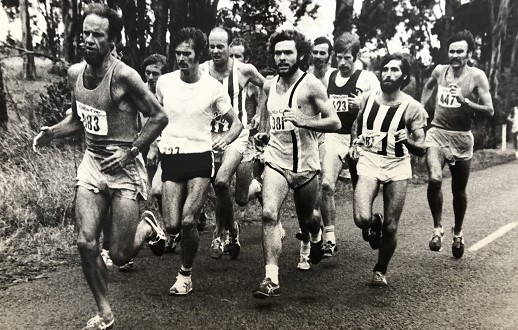
For the next three years before taking up marathons. Steve competed in this vein, adopting a full winter racing program of NSW AAA championship events crammed between other club commitments and fun runs. He was a constant in the NSW and Sydney racing scene, competing with gusto, winning races and improving year on year. Particularly noteworthy were his two wins and two second places in the NSW 25 kilometres championships during four consecutive years, 1977 to 1980.
4. The Victorians and Falls Creek
Aged 20, Steve got a taste of Victorian competition by racing in the 1978 Victorian Cross Country Championship at Bundoora. The Bundoora course in the 1970s was to the Victorians what Landsdowne became to the New South Welshman in the 1980s, well-trodden paths that many of the greats of each state raced on. Dare I say ‘hallowed ground’? Held on 28 July, Steve finished 11th, two minutes behind an in-form Austin. The next four were Chris Wardlaw, Deek, Max Little, and Rob Wallace, in that order. This race was a reminder to Steve that he had a lot of work to do to match the Vics.
While Steve was running well in the late 1970s, and NSW standards were lifting, he professes that he had great admiration for the Victorians. As a youngster he had followed the progress, and many great deeds, of Bill Scott, Wardlaw, Dave Chettle and Austin with interest. Of course, Queenslander Gerard Barrett was the X factor in Australia for quite a while that also attracted his attention. He was in awe of the Victorians and the depth of their distance running scene. It was only when he got to meet them and train with them that he understood that ‘they were human just like me.’ However, as Steve said: ‘Melbourne was the hotbed and NSW was in catchup mode’ at this time. ‘Depth wise, we didn’t really compare.’
December 1980 was when Steve first made the trek to Falls Creek, a summer trip he repeated for a number of years. Steve recalls that ‘I heard about Falls Creek through reading about Bill Scott and Dave Chettle, who were my early inspirations, along with Albie Thomas. I went up there early. I hired a unit. In fact, Len Johnson was the only one I really knew to begin with. Back then it was very informal. There were no organised altitude training camps, like those that began in the 1990s. We just lived and trained and talked. Later it became much more structured with more coaches involved and learning sessions. Anyway, in 1980 I just soaked it all in. It gave me a lot of confidence to understand these guys were just like me. Listening to the best in Australia, coaches and runners like Deek, Wardlaw, Clohessy and Telford, and training with best in Australia was a great experience. I also enjoyed the camaraderie of many others like Joe Murphy, Damian Cook and Greg McMahon and a large cohort of women elite runners. I learned so much from it. On the long runs I held my own. I even remember doing speedwork with middle-distance men like Tim O’Shaughnessy, Pat Scammell and Steve Foley.’
Although Steve did train in group settings in NSW from time to time, given the high volume ‘I did a lot of training on my own, midweek 18 milers, whereas I learned the Victorians did a lot of group sessions. I was never jealous of it but appreciated it could make a difference. They were the proof.’ While the top NSW guys would get together occasionally it was not a routine arrangement like many of the Victorians appeared to have. Andrews lived in Baulkham Hills, Morgan in Newcastle, Whitty in the Eastern Suburbs and Lloyd at Church Point.
Steve always came back from Falls Creek full of enthusiasm. He laughs when he remembers Rob McDonald’s reaction to one of his visits. ‘He got fed up with me going on and on about the Vics, and once said in exasperation “don’t keep talking about the Vics. They are our enemy.” Though Steve never felt that way, Rob’s comment is a reminder of the healthy competitive nature of the NSW: Victoria relationship that is always present.
5. Heat
Steve advises that he ‘hated training and racing in hot conditions. That’s why I never ran in Honolulu, though others I ran with did. Though I did take a chance in Hong Kong’s hot weather marathon in 1992. I trained through summer for their marathon. It was a slow race. But I generally steered away from marathons known to be run in hot conditions. Sydney’s summers could be brutal. I never ran well, even on the track. I just switched off over summer. I could last until early December when Zatopek was on, but after that I was gone. I couldn’t do track work in the heat. If in 14:30 shape, I’d be running 15:30. There were times when I ran well in summer – for instance in the NSW 10km Championship in 1980 I finished third. But we were lucky to strike a cool day. I finished third behind Andrews in 29:44. It was the first time I beat 30 minutes. That’s why Falls Creek was so good. It was a break from the heat and I was back to normal. If I was running 14:30 in Sydney for 5k, I could go through half way in 14:30 at the Zatopek, that was generally run in cooler conditions.’
6. Marathons
The further Steve raced the more competitive he was. He realised early on that his optimal race distances were 25 kilometres and the marathon. Steve was five foot eight and less than ten stone wringing wet, a compact bundle of muscle, ideally suited to the marathon. After his debut in 1980, marathons became the centrepiece of Steve’s distance running experience. He was either training for or recovering from marathons. Steve’s lack of speed, exceptional natural endurance and dislike of running in the heat made this an easy decision.
Emphasising his lack of speed, Steve recalls that ‘Lawrie and I made a pact in 1981 to try and make the NSW 1500 final. I had a PB of around 3:56 for 1500 metres at the time. We both missed out on making the final, me by 2/10. I ran 3:55.1. We were up against some good middle distance types.’
For the purposes of this article, I have highlighted some of his performances in the NSW Marathon Championships, the IAAF World Cup Marathons and his personal best run at Invercargill. This aptly covers a range of events over his whole period of marathon racing, providing insights about Steve’s attitude and what he faced in his attempts to achieve Games representation. The bare bones of Steve’s marathon experience can be described as:
Personal best of 2:16:41
18 completed marathons – slowest 2:22:38
Six wins
15 sub-2:20
Six Australian singlets
Three IAAF World Marathon Cup representations – 1985, 1987, 1989
Twice placed in Australian Championship – second in 1986, third in 1992
Four times NSW Champion – 1980, 1981, 1988, 1990
Consistently ranked in the top 10 nationally
Two DNF due to injury – Fukuoka 1987 and Canberra 1995
In his own words, Steve describes the reason for his transition to the marathon and reflects on his career in this way: ‘After running races from 1500 to 5000 metres track and up to 10km cross country for the last few years of my school days, I found that moving up to longer distances gave me better results in races. While I didn’t decide to run marathons until I was 23, I’d run quite a few 25 kilometres races and half marathons in my early twenties. NSW State 25kms and, although there wasn’t a lot of half marathons, I’d run my club Sutherland’s half marathon several times, getting my times down to 65:43. My motivation came from moving up to longer distances and doing fairly well. I was doing longer 18 to 20 miles training runs in my early twenties so marathons were the next step up for me. I had no desire to start running ultra distance races, a marathon was far enough for me.’
6.1 NSW Context
Apart from the performances of John Stanley, the NSW marathon ranks were in the doldrums post Farrington’s relocation to South Australia and eventual retirement from first class racing in 1978. When Steve came on the scene, Stanley was still running well, and he continued to do so for a number of years. Born ten years earlier than Steve, with a PB of 2:17:04, Stanley had a similar range of marathon ability and the same degree of consistency as a sub 2:20 performer year on year. He raced his eleventh and last sub 2:20 in 1983 at Fukuoka, the same year he set his PB.
Along with Graves, there were many good class clubmen who ran lowish to mid 2:20s, some of mature vintage, the best of them being Montague and a highly competitive Horst Wegner. The latter ran 2:18:07 in Hanover in 1978 shortly before settling in Australia, as well as a 2:19:49 in the 1979 Australian Championships, and continued to hit 2:20 – 2:22s in his mid 30s. Steve notes that around 1980 elite runners like Lloyd, Whitty and Morgan were starting to experiment with marathons, dabbling in this arena. Morgan was the only one to stay with marathons as their main race distance, but illness affected his performances, and Lloyd concentrated on track after his triple Melbourne Marathon wins (1979 to 1981) and one other promising effort of 2:14:36 at the Australian Championship in 1984. Boltz didn’t arrive on the marathon scene until 1984 and left Australia for greener pastures in 1988. And Andrews only had a couple of serious attempts late in his career, his best being a 2:14:44 at Chicago in 1988.
Whitty made a big impact during the 1980 and 1981 calendar years competing in nine marathons from April 1980 to March 1982, six of them overseas (including two at Fukuoka) and winning the Australian Championship in 1980. He ran his three fastest marathons (all 2:14s) in the twelve months ending 28 March 1982, the last being a win in the Seoul International Marathon. All of this achieved by the age of 22. Thereafter his participation in marathons was sparse as he concentrated on track and shorter events, representing Australia at the Brisbane Commonwealth Games in the 10000 metres.
Given this context you could argue that Steve was the last elite NSW marathon runner standing by the mid 1980s.
6.2 NSW Marathon Championships
Although billed as the selection race for the NSW team to compete in the Australian Marathon Championship, for many years the NSW Marathon Championship appears to have been the poor cousin to other domestic marathons. With little participation by higher profile distance runners, the victories often went to solid clubmen rather than topline elites. Though they were regulars at the National Marathon, Farro (1973 2:11:13 and 1974 2:17:31) and Stanley (1977 2:25:19 and 1983 2:24:11) only ever officially finished two NSW Marathon Championships, all wins. This was partly a result of circumstance but also because of their preference to compete overseas. Though Steve raced four State Championships, he found himself in the same situation. Another complicating factor was the change from June to Anzac Day weekend for scheduling of the event (1984 to 1990), resulting in a calendar clash with the Canberra Marathon also held in April. And notably many of the top overseas races were held in April.
In a footnote to the history of this event, in the 1974 edition there were medical certificate mix-ups involving Stanley and Alan Robinson, the second placegetter of 1973. Not medically cleared to race, both were forced to withdraw from the title, yet allowed to participate in an unofficial capacity. Stanley started one minute after the gun, finishing in 2:27 (including the extra minute) in third place, but was not recorded in official results. Robinson did not start.
Steve won all of his NSW Marathon Championships by significant margins of 2:57 in 1980 (2:19:48), 5:51 in 1981 (2:17:07), 7:52 in 1988 (2:18:36) and 7:49 in 1990 (2:17:50). However, what lies behind these performances is what tells the story. And as readers will see, the 1980 championship is quite a story.
6.3 Chalk and Cheese: 1980 and 1981 Wins
Steve made an immediate impact winning the 1980 and 1981 NSW Marathon Championships in under 2:20. An examination of these races provides a contrast of how race organisation can easily go wrong versus efficient event management. Both were held at a time when unregistered runners/fun runners were becoming commonplace and the NSW AAA were grappling with their integration into club association events.
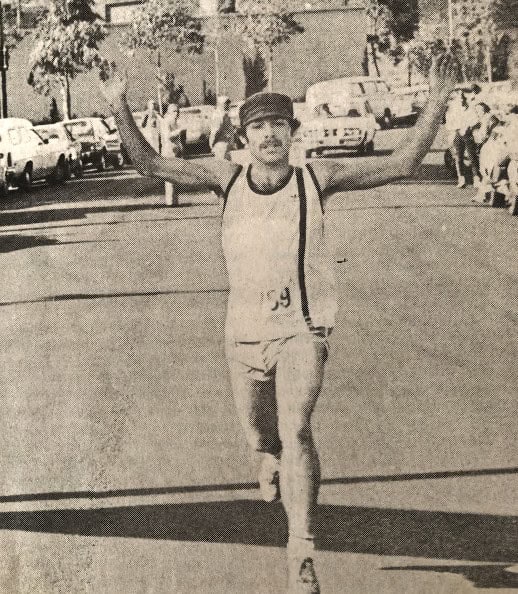
6.3.1 1980 NSW Marathon Championship
Held on 22nd June, the 1980 event was the first occasion that non-AAA registered runners were allowed to compete and there was an overlay of the amateur versus professional hang-ups of days gone by. By all accounts it was a shambolic affair, and I said to Steve that it must have been a nightmare. However, typical of Steve, who is not one to criticise, he seemed oblivious to all of the activity that surrounded him on that day. His only clear recollection was that ‘there were cars everywhere. I remember following the police motorbike and I had to stop once because of the traffic.’ But I guess the guys upfront had comparatively less problems than the bulk of the field who had the full weight of its poor organisation to contend with. Race reports and letters to the editor of Australian running magazines were scathing in their criticism. The only positive remarks being that the event was back in Sydney, the course was good, though it was undulating, and the inclusion of non-registered athletes was viewed as a beneficial decision.
Steve Pollard, a roving sometime reporter for Fun Runner, and a decent marathon runner, covered this championship in depth. Combined with a long letter to the editor of Australasian Track & Field by a concerned spectator, it makes entertaining yet horrifying reading. Apparently, it all went pear shaped when the Race Organiser to be used by the NSW AAA withdrew at the last moment. There were concerns about lack of traffic control (the course contained 110 major cross roads), no police escort for the lead runners until after halfway, a cyclist who stepped in to help the lead runners was nearly hit by a car and was threatened by an official with Steve’s disqualification if he continued to assist the runners, inadequate hydration and sponge stations, scarce toilet facilities, many near misses between cars and competitors, and quite a few instances of participants going off course due to lack of race marshals. Pollard notes that competitors (of which he was one) did not hear any call to the start line, and there was the absurd situation of lead runners being told by an official at the turn around point that ‘they must file behind him.’ He adds that ‘someone forgot to tell the police that runners had to negotiate busy intersections against the lights.’
The letter writer stated: ‘In the time I was watching Poulton he had to three times stop and dodge cars making left turns, and another time 3km from the finish had to run in between two lanes of heavy traffic then cross a six-lane road to make the left turn into Derby Road with only the assistance of the cyclist….In viewing the marathon I was amazed at the time of the runners. I am sure on a course where the runners didn’t have to worry about being hit by cars they could have carved at least a minute off their times, especially Steve.’
It’s worth noting that this was Steve’s first marathon and he was unsure of his ability to race over such a long distance. In fact, three and a half months beforehand, on a cool day, Steve did a training run where he ran the equivalent of a marathon, ‘round and round’ through suburban streets. More than anything, ‘I wanted to see what it felt like.’
The marathon started outside the Sydney Cricket Ground at 9am in cool, crisp and cloudless conditions. Watched by his parents, Steve didn’t disappoint. It was to be his day. The lead pack of seven (including Stanley who DNF, and ultimate placegetters Paul Lockyer 2:22:45 and Nick Hearnshaw 2:23:10) hit halfway in about 70 minutes, and thereafter slowly started to break up. Steve surged into the lead at 25 kilometres, and by 30 kilometres was well ahead running to an easy win, if you can ever call a marathon easy. Steve’s time was the third fastest ever for a NSW title, behind Farro’s 1973 and 1974 winning times, an auspicious debut in trying conditions. Sutherland won the teams race (of three runners) by one point ahead of Western Suburbs.
Just to emphasise that integration with the fun run cohort (recreational runners was not a term used at this time) still had a way to go, two separate sets of results were produced: for the NSW AAA State Championships and the Fun Run Marathon. Compared to current day events, the fields were incredibly small. There were 114 registered club runners who finished the championship event, the slowest being 3:26:10. There was one registered woman, Merri Tindale (later Mack), well known in NSW distance running circles who ran 3:17:10 for the only marathon win of her career. The recorded winners of the fun run are P Jullian in 2:28:40 and Rae Bolton, 3:06:54. It appears there were only 250 starters, with a smattering of women, across both event categories. The cut-off for stragglers was four hours, there being no leeway for slower participants in this era where open competition was all the go.
6.3.2 1981 NSW Marathon Championship
If 1980 was shambolic, 1981 was a display of military precision, and it was appreciated by those who ran the year before. Backed by the Sydney Marathon Clinic, the Australian Army, and a horde of volunteers, there were no complaints. The course was within the confines of the Holsworthy Army Camp and described as ‘relatively easy except for a long straight and the uphill grass finish’ the latter casting doubts on its compliance with IAAF regulations. Steve recalls that ‘the 1981 State Championship ended up being my second fastest marathon. Charlie Lynn was the main organiser.’ Satisfaction with the course was high, the next three editions also run at Holsworthy.
It seems peculiar seeing the images of Steve in Wests kit, knowing his strong association with Sutherland. However, his decision to change colours in 1981 was impactful as he led Wests to a teams win, Sutherland nowhere to be seen.
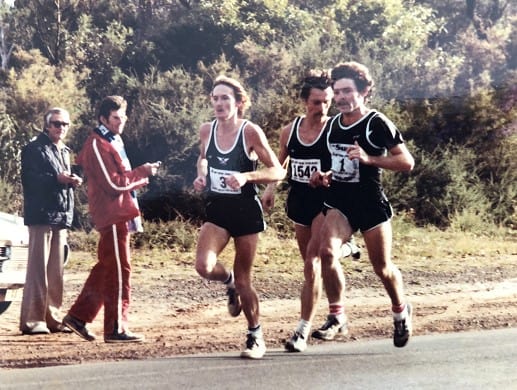
In true Army style, a howitzer was used to signal the 8:00 am start. Steve’s race plan was well executed. After Wegner faded and Lloyd dropped back at 27 kilometres, Steve was out in front and on his own from around 30 kilometres onwards. Though second outright, with a time of 2:22:58, Wegner was not mentioned in the State Championship results, having won the Fun Run Marathon category. He’d recently undergone a hernia operation and was too late to enter for the AAA category. Lloyd dropped out with four kilometres to go, saying he ran out of steam and was sick, and intended to set himself for the Melbourne Marathon – which he did and he won. As for Steve, he had his sights set on representing Australia for the first time in the Montreal International Marathon later that year.
[With Trevor Vincent impressing as manager of the team, he placed 14th at Montreal in 2:17:26 behind Whitty’s career best of 2:14:01 for sixth. After being in real contention, the Australian Team finished third in the Nations Cup (Stanley 2:17:55, Graeme Kennedy Vic 2:19:10, Morgan 2:21:46) behind Canada and Colombia. Unfortunately, team and individual performances were affected by a mishap during the race. Steve was running well after half way, ’powering’, before Rob Wallace and Morgan collided at a drink station, and Steve stopped to render assistance. Wallace DNF and Morgan never recovered from the incident.]A 1982 program profile of Steve describes his change in preparatory training for the 1980 and 1981 events. Prior to the 1980 event Steve was running 190-200 kilometres per week, made up of 14 to 15 sessions, his longest run being 28 kilometres. By 1981, he had increased his volume up to consecutive weeks of 220-230 kilometres.
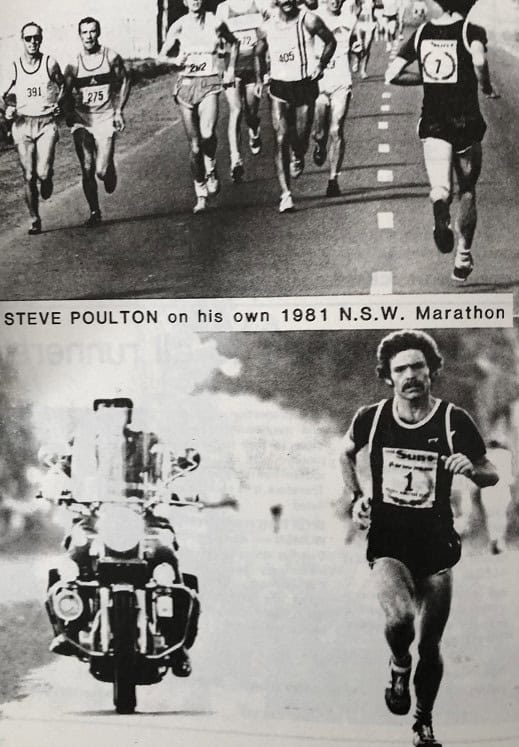
While pleased with his performance, he stated that it left him ‘constantly tired. I guess its all experience, but I’m not convinced that by just running 230 kilometres per week, that you have to run well. Consequently, I ran my second marathon feeling tired and not really fresh.’ In the same breath he acknowledged that his big mileage background was beneficial, when after spending the next three weeks recovering from the marathon, in one of the best races of his career he placed third in the Australian 25 kilometres Road Championship.
In a more welcoming race environment, overall numbers were up on the previous year with a combined total of 377 finishers for the State Championship and Fun Run events, the last competitor running 5:08:49. As if to emphasise the continuing division between club athletics and recreational runners, the Championship and Marathon Fun Run results were published separately in the August issues of Australasian Track & Field and Fun Runner respectively. Each discipline in their own box, so to speak.
6.4 An Interlude with Vainio
Distance running is an egalitarian sport, runners generally sitting in two categories of their careers as they train on – on the way up or on the way down. And that means scrubbers and elites can unexpectedly rub shoulders at times, wherever they happen to be.
Throughout his career, Steve was a regular visitor to New Zealand. He explains that on one occasion ‘I travelled to New Zealand in January 1980 with Rob McDonald and Peter Waters (coach of McDonald). While there I ran a decent ten miles race, getting out-kicked by Martti Vanio of Finland who was the current European 10,000m Champion. ‘I chased him the whole way. He dropped me in the last kilometre. He was tall and I only came up to his waist. I beat McDonald and Kiwi international Derek Froude by good margins. Vainio was subsequently done for drugs.’ Steve’s diary shows the results as Vanio 49:14, Steve 49:25, McDonald (Aus) 49:50 and R Toivola (Fin) 50:04.
Six years later, as a result of their first and second place performances in the Australian Marathon Championships, Austin and Steve won a trip to the Chicago Marathon in October 1986. ‘In Chicago I happened to be in a lift with Vainio. He didn’t recognise me in the first instance until I used patting down hand signals to indicate my height and mentioned the Taupau 10 miler of 1980. He smiled as the recognition dawned on him who I was. He looked straight at me and said in broken English ‘I remember race in Taupau and little Aussie man.”’
In a career that attracted controversy, Vainio was a dual Olympian, banned for life in 1984 and stripped of his 10000 metres Olympic silver medal from Los Angeles but allowed to return to competitive athletics in 1986.
6.5 IAAF World Marathon Cups
While Steve was never selected for a Games team, he did compete in three editions of the prestigious IAAF World Marathon Cup: 1985, 1987, and 1989. He was also selected for the 1991 team but declined due to injury. Team places were determined by the first three from each country. All three marathons were superbly organised with large spectator participation. Held in April, they clashed with the NSW Marathon Championship.
Again, his level of consistency was impressive: 2:17:30, 2:19:22 and 2:17:39 for placings of 59th, 58th and 34th respectively. He was the only Australian to compete in all three editions, and the best of the Australians in 1985 and 1989.
6.5.1 Hiroshima 14 April 1985
The year prior to Hiroshima Steve proved himself for selection by two solid marathon performances. Firstly, Steve raced the Adelaide Marathon on 26 August 1984. It was a traffic free course, and a cool day, but it was windy. Steve ran strongly, winning by over three minutes in 2:20:23. He had negative splits of 71:40/68:43. Though the course has changed this remains the fastest time for the Adelaide Marathon, a slim four seconds faster than Victorian Paul O’Hare ran in 1983. This was followed by another sub 2:20 in the Winstone People’s Marathon held in Auckland in November 1984, finishing second to Kiwi international Don Greig, 2:18:03 to 2:18:41.
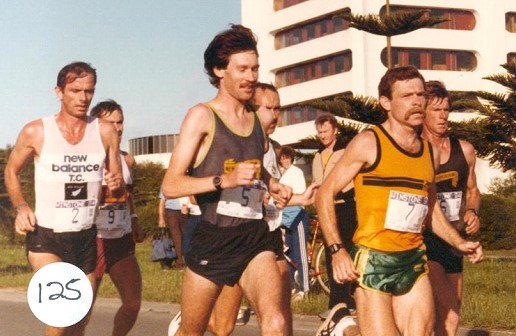
Steve states that ‘Probably one of my most memorable marathons was the first ever World Cup Marathon in Hiroshima in 1985. There were several big city marathons on around the same time – London, Rotterdam, and Boston – where many of the top guys were running, and not many expected a fast race in Hiroshima. However, the winner Ahmed Salah of Djibouti, won a close race in 2:08:09, just four seconds slower than Steve Jones world best set in Chicago the previous year. Fourteen runners broke 2:12, which, at the time of 1985, was extraordinary. I ran 2:17:30 and finished 59th.’
The dead flat course contributed to fast times by the top finishers. However, a race report written by Pam Turney in the Victorian Marathon Club (VMC) newsletter comments on the poor Australian Team performance, Pat Clohessy at a loss to understand why this occurred. Though it was acknowledged that Steve ran up to his best, Australia failed to register a result, affected by the DNFs of Boltz and Graham Clews, Wallace finishing second Australian behind Steve in 2:18:03. In a sign of the times Turney noted that just four minutes before the gun the Australian team were threatened with disqualification because the Adidas logos on their singlets were too big! The race authorities only relented when advised these were Australian singlets worn at the last Olympics.
6.5.2 Seoul 12 April 1987
The Seoul marathon was the trial event for the 1988 Olympic Games and a repeat win by Salah in 2:10:55. Conditions were cool. Steve was third Australian, 58th outright in 2:19:22, behind Queenslander Pat Carroll (2:17:39 48th) and Victorian Peter Mitchell (2:18:02 50th). Carroll came into the race as a quadruple Gold Coast Marathon winner with a personal best of 2:15:34. Mitchell, with a personal best of 2:14:59 in 1984, went on to represent Australia in the 1987 World Championships. His 2:18:02 was the second and last time he ever ran sub 2:20. Steve was slightly underdone. Having twisted his ankle the month before, he only made a final decision to compete at Seoul after successfully completing a 15 miles training run. Australia finished 12th, a relatively poor outcome, against fierce competition, with 160 competitors from 54 countries taking part. Italy won the teams race filling third to fifth places with the celebrated names of Bettiol, Nicosia and Faustini.
6.6 The Bookends
Steve book ended his first decade of marathons with repeat wins in the 1988 and 1990 NSW Marathon Championships. In a solid period of racing he also ran his personal best at Invercargill in November 1988 and achieved his best World Marathon Cup placing, thus far, in Milan. Leaving Barrett and Hoyle in his wake, Australia finished a disappointing 15th.
All, except Milan, were clinical performances by Steve, where he just blew the fields away and ran from the front for good wins by big margins. In particular Steve remembers Invercargill, his only sub 2:17, as a quick ‘in and out’ visit to New Zealand, with little fanfare, and a singular focus on the race. Aiming for 2:15 to ensure selection for Milan, it was a decent course, and a missed opportunity to run much faster. Conditions were ideal, the temperature sitting at 5 degrees Celsius. He had no competition whatsoever, and though a personal best it was a slower time than Steve had anticipated.
Sutherland and NSW AAA official, Alex Hutt, was ‘a fantastic event organiser for the 1988-90 NSW Marathon Championships’ and they went off like clockwork. Known as the Anzac Day Marathon from 1984 to 1990, the 1988 championship race started at Sydney Athletic Field. I was privileged to run in this race myself. Conditions were cool at the start but hotted up during the race. The main things I remember were the large lead pack early in the race, and the concentration on Steve’s face as he powered back towards me after the turnaround point at Sans Souci. There were the usual culprits chasing Steve, a considerable number who aspired to place, many who fell by the wayside, but no-one in his class on that day. Stalwarts of this event and previous championship winners, Montague beat Graves for second in slow times of 2:26:28 to 2:26:44, having cleared out from the rest of the field.
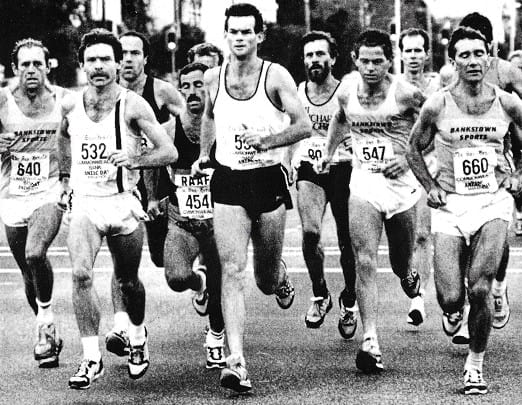
The 1990 NSW Championship was more of the same from Steve, his victory over Morgan equalling Roland Guy’s record of four championship wins during 1947 to 1954. In a weak field, his time of 2:17:50 brought some respectability to the race as a state championship. He kept the flag flying for Sutherland, clubmate Harry Ward having won the 1989 championship in a slow 2:30:30

7. The Zatopek 10000 metres
‘I only ran the Zatopek 10,000m three times in 1980, 1981 and 1988 resulting in two thirds and a fifth place. Although not great times compared to some Zatopek races, they were still pleasing to me.’ As Steve’s comments infer, these races lacked depth, major drawcards absent because of international commitments elsewhere and other factors. However, the winner’s times were relatively fast in the context of the available competition, weather and race conditions.
Steve’s results were:
18 December 1980: third in 29:20, behind Victorians Steve Austin (27:54.3) and Garry Bentley (28:44), in a small field of 10 starters, cool conditions, fair breeze;
17 December 1981: third in 29:08.7, behind Andrew Lloyd (28:25.4) and Barrett (28:54.4), 15 starters, 20C, mild with light wind; and
5 December 1988: fifth in 29:32.12, behind Harrison (28:42.55), Darren Wilson (28:45.11), Adam Hoyle (29:18.36) and Barrett (29:29.44) and just ahead of Kiwi John Bowden, 14 starters, 28C, 31% humidity.
Steve’s prep for the 1980 race involved a long drive to Melbourne from Falls Creek. Notably, Lloyd’s 1981 victory came only two months after his third win at the Melbourne Marathon. The 1981 result proved to be Steve’s career best time. However, given the hot conditions, the 1988 race may have been Steve’s best ‘performance’ at the Zatopek. Though held only one month after running his lifetime marathon best at Invercargill, this was a prime opportunity for a sub-29, but it was not to be.
The VMC race report of 1988 estimates that the heat cost the top runners 30-45 seconds, and a post-race account written by Harrison confirms as much. Despite the heat, a big group of runners, including Steve, were on 28:20 pace for the first four kilometres. Thereafter the pace slowed and the field split from halfway, only Darren Wilson able to put up any resistance to Harrison’s long run for home. Steve says he can’t remember much about this race at all, though as many readers will attest this can sometimes be the case for our best competitive races, when you are in the moment, in the zone.
In a sarcastic comment, reflecting his disappointment about lack of spectator and financial support for this VMC run event, club president Fred Lester noted that ‘the 232 adult paying customers plus athletes, officials and sponsors went away well satisfied with a great week and main night of sparkling athletics!’
8. The Bacchus 12000 and Crackenback
‘I had one of my best runs at Griffith in 1980 in the Bacchus 12 kilometres finishing a close second to Steve Austin after being lapped by Steve two or three times in the National 10,000m track championship and Moscow Olympic Trials in Sydney one month earlier. I also had another good run there in 1979, when most of the World Cross Country team ran at Griffith at Easter. I finished third behind Rob DeCastella and Chris Wardlaw, somehow managing to beat several Aussie World Cross Country guys.’ Steve fails to mention that he also finished fourth in 1981 behind Austin, Whitty and Lewry, second in 1983 to Boltz and second again behind Austin in 1986, 34:55 to 35:34, a much older Wardlaw finishing fourth.
First run in 1975, the Bacchus was a premier event attracting topline runners from NSW, Canberra and Victoria during the 1970s and 80s, prize money and overseas trips being on offer. Held at Griffith during Easter, it sometimes coincided with the return of Australian representatives from their World Cross Country tour. It allowed up and comers to compete against Australian internationals, giving them an opportunity to prove their mettle. The course had some variations over the years and early in its history it was clearly under distance. It was a demanding course and places were often determined in the last 300 metres sprint to the tape after passing through the gate onto Exies oval.
The 1979 Bacchus was an ‘exhibition’ race by Deek with a big win over Wardlaw. After breaking away from Rabs up Scenic Hill Deek ran away from the field over the last three kilometres, easily beating Rabs by 350 metres. Steve was described as running ‘the race of his life to hold off a fast-finishing John Stanley’ (the inaugural winner, 1975, in 35:12) and Little. A big improvement on his 12th place of 1978. Notably Steve was also the recipient of a return air fair prize from a hat draw of third to 10th male and second to third female finishers. So, he didn’t walk away empty handed.
The 1980 race was the most significant Bacchus result for Steve. A brutal affair, he finished 12 metres behind Austin. After the pack dwindled to five at half way, it became a race in three, with Steve, Austin and McDonald jockeying for the lead in the later stages. Steve passed Austin twice in the last half mile. In a thrilling spectacle, Austin had to pull out all stops for the win (38:19) surging ahead of Steve and McDonald just before entering the oval, and after McDonald had suffered a stitch at one point. Andrews and Rob Neylan of Victoria were further back in fourth and fifth. While Andrews had yet to make his international debut, Austin (1977, 1979) and McDonald (1975, 1979) were already two-time Australian representatives at the World Cross Country Championships.
While the 1980 Bacchus was a career highlight for Steve, it served as a warm up for an astonishing win the next day in the Up the Mountain race, two kilometres of a near 2000 feet vertical climb from Thredbo Valley Terminal to Mt Crackenback Terminal. Having driven his Bedford van straight to Thredbo from Griffith with some university mates, his preparation was not ideal. Despite any combined after effects of Bacchus and the long drive, Steve recalls that ‘the route had no clear path or track and I just concentrated on following the underside of the chairlift all the way up.’ Winning by nearly two minutes from 86 starters, his time of 20:08 decimated Laurie Toogood’s 1972 mark of 21:07. This was no mean feat given Toogood’s pedigree as a past Australian 1500 metres track and cross country champion (beating Benson and Clayton in 1967).
Writing seven years later Brian Lenton relates the significance of Steve’s performance in a light hearted manner. He talks about a doctor who had witnessed Toogood and Steve’s performances. Apparently, he had calculated/forecast ultimate race times in 1972 based on some medical formula, and had thereafter described Toogood’s run as ‘a physical impossibility.’ As Lenton states: ‘This same doctor may well have had a coronary in 1980 while watching Steve Poulton take almost a minute off the record….Due to course changes in 1984 and 1985 Steve’s run will be similar to an Olympic medal – his to keep forever….Steve’s competitive performance was impressive, beating John James (the 1976 and 1979 winner) and Jim Box (who overall has the best competitive record in the race’s history).’
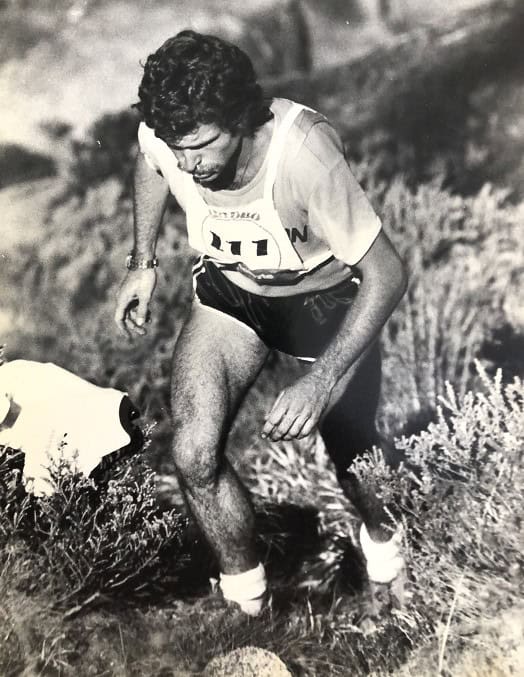
The 1981 Bacchus was reportedly marred by some poor race organisation and a significant decrease in the number of competitors compared to previous years. The competition at the front was hot, even if the overall depth was not great. Whitty and Austin dead-heated in a time of 37:57. In what was considered a questionable decision of double standards, Whitty was deemed not eligible for prizes as he was a late entry (though I assume his entry must have been accepted for him to be allowed to race). Victorian and World Cross Country rep Bryan Lewry was way back in 38:39 with Steve another 19 seconds behind him, but ahead of NSW compatriots Morgan (39:09) and McDonald (39:53). Lewry was a three-time World Cross Country rep (1977, 1979, 1981) finishing his career with a fourth representation in 1983.
9. Cross Country
During the 1970s and 80s there were NSW cross country championships over a range of distances, held annually. However, the shorter distance of 10 kilometres was the primary vehicle for state selection to compete in National Championships. By 1976 the NSW and Australian Championship had settled at 12 kilometres, in alignment with the World Cross Country race distance. Over the years Steve competed in all of these different events, sometimes winning and often placing in the top three.
Steve said to me that although he preferred the road ‘I was strong on hills but had no natural kick. I was suited to cross country and in particular the tough Lansdowne course.’ Steve had an impressive record in NSW Cross Country Championships, with many first three placings, and nine appearances at the Australian Cross Country Championship from 1976 to 1994. As late as 1994, aged 36, he was able to finish second to David Lightfoot in the NSW Championship (Barrett actually second outright), another sign of his longevity in a discipline that he enjoyed but always found challenging.
It seems that Steve was unlucky never to be selected for an Australian Cross Country Team, while many of his NSW peers, opponents that he was on equal terms with, managed to achieve that honour. His best national placing was 11th in 1979. From 1980 onwards marathon racing became his priority, and combined with over-racing on the roads this may have affected his ability to peak for World Cross Country trial races and national championships – something I have surmised, though Steve does not agree. Steve’s own assessment is: ‘I was not quite good enough and I lacked the speed at the start of cross-country races required at that level.’
While I think his self-doubt may be unfounded, it could be some sort of karma that the only minor regret of his career concerns a missed opportunity in cross country. Steve recalls: ‘In 1980 I was still studying under the auspices of the Ron Clarke Foundation. I went to England early in the year on a family and running holiday. While there I joined Highgate Harriers and I ran some cross-country races. I beat Dave Bedford in one race, though he was well past his best. And I was asked to run for Highgate in the English National 9 miles Cross Country Championship at Parliament Hill Fields. But I declined because I was afraid of missing a further week of university, which in hindsight wouldn’t have made any difference to my academic outcomes.’
Of his many performances in the NSW Cross Country Championships Steve states: ‘The 1984 Championship was the only one I won. Actually, Gary Briggs, the Queenslander and World Cross Country rep, won outright and I was second.’ Briggs, well known as a cross-country exponent, and a beautiful stylist, hit a purple patch during 1983-86 with three second places and one win (1985) at the Nationals. In 1984 he placed second to Garry Henry.
Steve recalls finishing second to Morley in 1983. He ran the NSW Championship on Saturday and the Cronulla Surf Club Fun Run the next day, his main opposition being a fresh Jamie Harrison. ‘In a tough race I outlasted Jamie during the last two or three miles and won a Gold Coast trip for two which I gave to my aunt and uncle, who were visiting from England. Jamie did not run the day before. He had saved himself.’ That win gave Steve a lot of satisfaction.
10. Parramatta Ten
Held annually on the second Saturday of June, the inaugural Parramatta ten miles road race was in 1976. Hosted by the Parramatta DAAC it became a significant winter fixture of the NSW AAAs. The ‘Parra’ counted towards the Winter Distance Runner of the Year Award and was heavily supported for quite a few years. It was just over five laps of nearly two miles on the road within the park environs, flat and fast, and most of the top guys raced it at one time or another. The winner list is like a who’s who of NSW distance running. The lap course allowed spectators a good view of the race close up as the runners passed by, and at different vantage points on the circuit, which built excitement about the final outcome.
Steve ran it for five consecutive years from 1977 to 1981, and again in 1986 (finishing second). He won it in 1977 (49:41) and 1981 (50:20), and achieved his best times when finishing second to Andrews in 1978 (48:34 to 49:07), second to Brian Morgan in 1979 (48:41 to 49:19) and fourth in the legendary race of 1980 behind McDonald, Morgan and Whitty (47:49, 48:01, and 48:09 to 48:40). Steve remembers the 1980 race like it was yesterday. The pace was extremely fast, and Steve was in the lead pack most of the way, only fading towards the end. This was more a case of McDonald burning the others off than any of the top three slowing down. McDonald was in great form that year, winning everything in his path apart from the NSW 25 kilometres Road Championship, where he was ‘thrashed’ by Steve a few weeks earlier (in a depleted field Steve beat McDonald by 73 seconds). Frank McCafferty described it as ‘sweet revenge’ for McDonald, also noting that Steve was a ‘brilliant’ 25 kilometres racer but maybe not as effective at the ten miles distance.
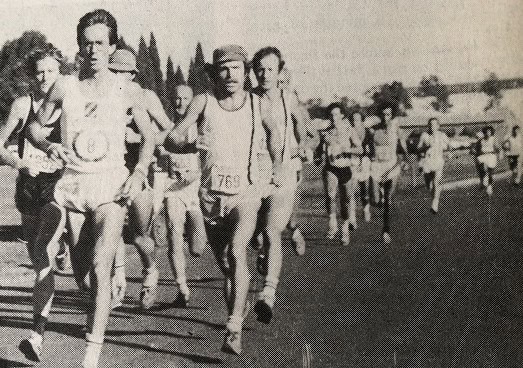
The 1981 edition was a very slow time, but Steve took some impressive scalps, easily beating Lloyd and Andrews, and the very young duo of Morley and Boltz. For this year the route was four of a longer two miles lap. ‘Road works meant that competitors were diverted onto grass each lap, many saying that it may have added over 90 seconds to race times. I was doing 140 mile weeks during that period. Too much mileage. However, before the race, based on Pat Clohessy’s advice at an ALCOA training camp, I cut back the mileage and ran well.’

11. The Wind Down
Post Steve’s fourth NSW Championship win Steve continued to compete to a high level over a range of distances in NSW and national circles. One highlight was finishing tenth outright in a loaded field, and third domestic runner, in the 1992 Australian Marathon Championships, just dipping under 2:20 for the final time. Barrett, now 35 years of age, finished fourth and won the Australian title in 2:16:46 ahead of Queensland’s Mike Inwood, 2:18:08. Seven internationals took top ten places. Steve’s second place at Hong Kong was also laudable, in hot conditions.
However, from 1993 onwards, Steve started to notice a high level of inconsistency, ‘peaks and troughs’, creeping into in his race performances. He cites the downturn in his annual race outcomes in the Sydney Morning Herald (SMH) Half Marathon as a signal of his failing ability to compete at the top level. He finished third behind Monas and Wayne Larden (ACT) in 1993, actually winning his last NSW Road Title, ‘eighth or ninth in 1994 in around 70 minutes’, and ‘fifteenth in 1995, beaten by a local Sutherland triathlete.’
By 1995 Steve just wasn’t competitive anymore, getting beaten by others who were not ordinarily of his standard. He knew it was time to finish: ‘I felt burnt out at the end of my career. And I know that Lloydy felt the same. We’d raced so much but I enjoyed it immensely. And looking back, I have never thought that I could have got more out of myself.’
12. Training and Philosophy
Steve’s training tended to be high volume all year round. He was a big mileage man. Of training Steve says ‘You learn more about running as you go. I had a high level of commitment. For example, if it was pissing down, I just went out and did it. Hindsight is a great thing. As I got older there was more of a structure to my training. I ate no special food, only a balanced diet.’
‘During the early 80’s I met Pat Clohessy at a National Training Camp and Pat offered advice and a good weekly training cycle involving long running, hill work, track work and most importantly easy running which I used for the majority of my running career.’ It was similar to Deek’s training pattern.
In a self-written profile for the 1982 NSW Marathon Championship program Steve laid out his Clohessy influenced training schedule as:
Mon: Noon 10km Evening 16km
Tue: Noon 10km Evening 13km
Wed: Evening 27km
Thu: Noon 10km Evening 13km
Fri: Noon 10km Evening 13km
Sat: 16km run or race
Sun: Morn 28-32km
Shorter runs were about 3:45km pace, longer runs at 4-4:20 pace. Tuesday’s noon session would include hill work. Wednesday’s long run was undulating along a ‘pipeline’. Thursday’s evening workout was a track session and would include reps of 8×400, 6x 1km or 4/5 x 1 mile. He stated that under this regime his training was more consistent and he felt stronger than he’d been before.
More recently, Steve states that apart from marathons and road running, a good winter cross country training and racing program was important to him. He didn’t really race much track during summer. Track was his ‘off season’.
13. Injuries
Apart from the back injuries early in his career, Steve advises: ‘I had quite a few injuries, usually from overtraining. Planta fascia took about 12 months to get over in my mid 20’s (1982) and several stress fractures in my younger days. The later years I had strained calf muscles and often got injured from track training and track racing. In hindsight, I ran track intervals way too fast.’ In-between marathon races, Steve was out injured for extended periods of time during 1983 to 1985, which seriously affected his ability to compete, and undoubtedly stunted his progression. When injured he would revert to cycling. He did some stretching, and only tended to do regular exercises if required as part of physio to rehab an injury.
14. Concluding Comments
This article is as much about the state of the NSW distance running club scene half a century ago, as it is about Steve’s personal journey. A window in time about the day in day out of grass roots competition. Not always a pretty picture when contrasted against the rich experience of some of Steve’s international races, but a full gamut of what the distance running world can deliver, nonetheless.
Steve had his fair share of injury and disappointment. This was to be expected given the longevity of his career. Recurring themes were too much volume and too much hard track work, and concomitant injury. Is it ever so for distance runners, many burnt by the chase? But Steve always bounced back. He learned from his own experiences, and that of his contemporaries. He was resilient, practical in his approach and realistic about what he could achieve.
Steve was elite but not elitest. He remained grounded in NSW club running. Clearly, he made the best of what he had. And while he found his niche in the marathon, he never took it for granted. He brought respectability to the NSW domestic marathon running scene by his consistency. But there was never an ‘easy marathon’ for Steve. In his words: ‘I always found the last few kilometres tough in a marathon no matter what the circumstances. Especially the last five kilometres.’
While there are sometimes tensions between officialdom and the athlete, Steve has always appreciated the giving nature of officials and those who assist others at club and international levels. Post his racing career Steve has mentored distance runners and managed teams at overseas race events. He is forever grateful to Dave Cundy for inviting him to be a member of the Sydney Olympics Road Events Team. As he says it was one of the best experiences of his life driving the lead vehicle for the Olympic marathons, with Dave’s wife Fran as passenger, and a contingent of others on the large gantry at the back of the vehicle: ‘The atmosphere coming over the harbour bridge was out of this world.’
For now, Steve says ‘I still follow athletics although I haven’t been able to run for ten years. I help my good mate Rod Gibb when he has school and state cross country at his property at Nowra several times each year.’
While a distance runner’s success is typically measured by times done and races won, it is also measured by attributes of perseverance and commitment to the grinding slog of the training required. Steve had these attributes in spades. Although he says he was never in the same league as the top Australian runners of the 1980’s, he had some exceptional races against many runners at his level in NSW, from other States, and at numerous National Championships, from the late 1970’s into the 1990’s.
Upon final reflection, Steve states that ‘I always thought that I did not have a lot of ability, but I was prepared to work hard. I never thought “I could have run quicker” if I’d done this or that when I stopped competing.’ Honest words that embodied his ethos as a distance runner. Working hard is what he put into practice.
Steve Poulton has no regrets.
Steve’s Marathons
22 June 1980: 1st NSW Championship, Sydney, 2:19:48
14 June 1981: 1st NSW Championship, Sydney, 2:17:07
13 September 1981: 14th Montreal, 2:17:26
9 May 1982: 20th London, 2:17:22
12 June 1983: 10th Australian Championship (4th Australian), Sydney, 2:17:21
26 August 1984: 1st Festival City Marathon, North Adelaide, 2:20:23
18 November 1984: 2nd Winstone People’s Marathon, Auckland North, 2:18:41
14 April 1985: 59th IAAF World Marathon Cup, Hiroshima, 2:17:30
8 June 1986: 6th Australian Championship (2nd Australian), Sydney, 2:17:15
26 October 1986: 25th Chicago, 2:19:11
12 April 1987: 58th IAAF World Marathon Cup, Seoul, 2:19:22
6 December 1987: DNF, Fukuoka
25 April 1988: 1st NSW Championship, Sydney, 2:18:36
6 November 1988: 1st Southland Marathon, Invercargill, 2:16:41
15 April 1989: 34th IAAF World Marathon Cup, Milan, 2:17:39
25 April 1990: 1st NSW Championship, Sydney, 2:17:50
20 April 1992: 42nd Boston, 2:22:38
12 July 1992: 10th Australian Championship (3rd Australian), Gold Coast, 2:19:39
31 January 1993: 2nd Hong Kong, 2:21:03
9 April 1995: DNF, Canberra
Sources
Documentation [from/recollections of] Steve Poulton during email, phone and face to face meetings with author on 7 September 2025, 9 September 2025 and 10 October 2025.
Publications:
Lenton, B, Distance Running in Australia, 1978
Lenton, B, Unfit for Publication, 1986
Websites and magazines:
ARRS.run
Athletics Australia Almanacs, various
Australasian Athletics, Official Journal of Track and Field, various
Australian Runner, various
Ausrunning.net
Australasian Track & Field, various
Fun Runner, various
Marathonview.net
Victorian Marathon Club Newsletters, various
Wikipedia.org
Worldathletics.org
https://griffithferals.org.au/
https://mountainrunningaustralia.org/